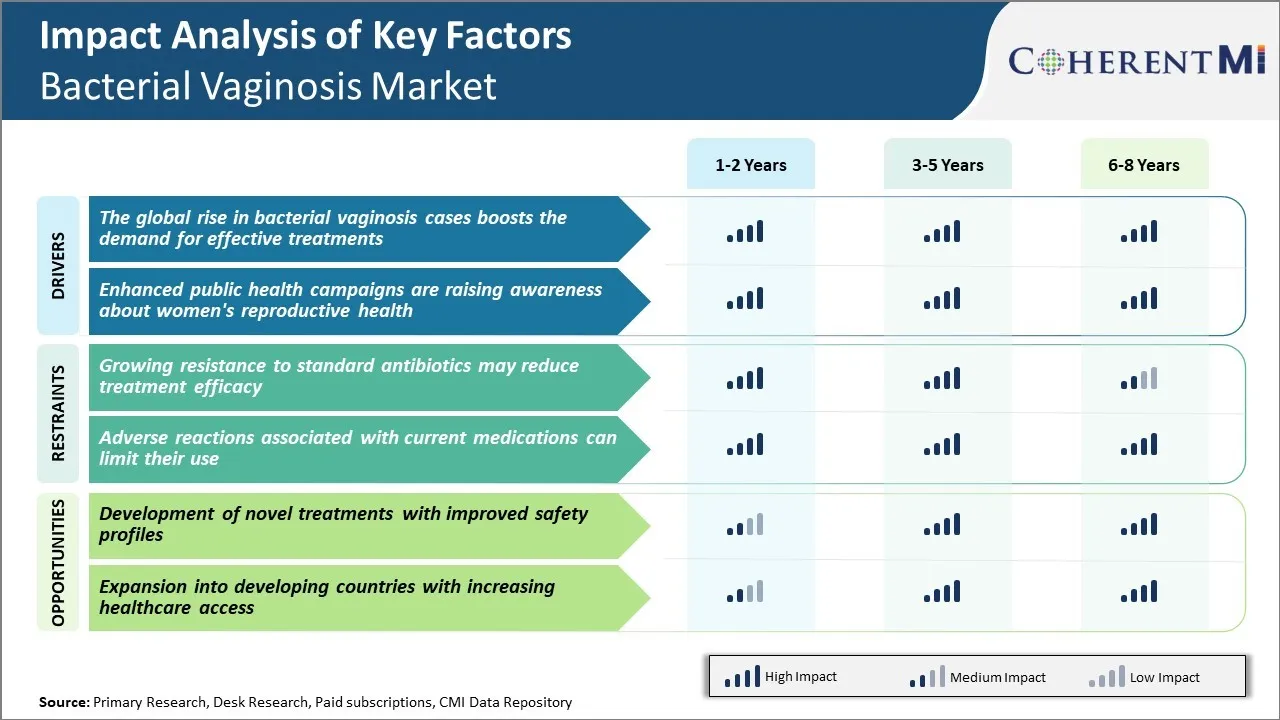Бактериальный вагиноз рынок АНАЛИЗ РАЗМЕРОВ И ДОЛЕЙ - ТЕНДЕНЦИИ РОСТА И ПРОГНОЗЫ (2024 - 2031)
Бактериальный вагиноз Рынок сегментируется по лечению (антибиотики (Метронидазол, Клиндамицин, Тинидазол), противогрибковые агенты пробиотики), по пут....
Бактериальный вагиноз рынок Тенденции
Глобальный рост случаев бактериального вагиноза повышает спрос на эффективные методы лечения
Бактериальный вагиноз или ВВ является одной из наиболее распространенных причин вагинальных инфекций среди женщин. Согласно нашему исследованию, за последние несколько лет мировая распространенность случаев БВ показала заметный рост. BV часто вызывает неприятные симптомы, такие как аномальные выделения из влагалища и рыбный запах, который влияет на качество жизни и благополучие пострадавших женщин. Это привело к растущему спросу на эффективные методы лечения, которые могут быстрее облегчить дискомфорт и полностью вылечить инфекцию.
Фармацевтические компании, занимающиеся разработкой вариантов лечения БВ, сообщили о значительном выигрыше, поскольку все больше пациентов теперь выбирают лекарства, а не игнорируют проблему или полагаются только на безрецептурные средства, которые часто обеспечивают временное облегчение. Рецептурные препараты, содержащие антибактериальные и противовоспалительные средства, являются предпочтительными для их целенаправленного подхода к избавлению от возбудителей бактерий и предотвращению рецидивов после завершения курса.
Растущая глобальная распространенность заболеваний, следовательно, стимулирует общий рыночный спрос на надежные методы лечения БВ. Фармацевтические фирмы активно работают над новыми лекарственными препаратами, комбинированной терапией и диагностическими инструментами для удовлетворения неудовлетворенных потребностей и расширения своей доли на рынке. В целом современная медицина, по-видимому, получает наибольшую пользу от этой восходящей тенденции в инфекциях, вызванных бактериальным вагинозом во всем мире.
Расширенные кампании общественного здравоохранения повышают осведомленность о репродуктивном здоровье женщин
В последнее время, с повышением уровня образования и ростом открытости в обществе, разговоры о проблемах репродуктивного здоровья женщин стали менее табуированными. Различные некоммерческие организации и государственные учреждения запустили обширные программы повышения осведомленности с помощью различных средств для информирования женщин об общих гинекологических инфекциях, таких как бактериальный вагиноз или БВ, и важности своевременной диагностики и лечения.
Эти кампании показывают, как частые вагинальные инфекции могут нарушить естественный баланс pH в половых путях, делая женщин более восприимчивыми к заболеваниям, передаваемым половым путем. Они подчеркивают, что БВ, хотя легкое заболевание само по себе не должно игнорироваться, поскольку оно потенциально может привести к оппортунистическим инфекциям.
Несколько телевизионных, радио и цифровых рекламных объявлений представляют откровенные, но разумные сообщения о признаках и симптомах аномалий, которые требуют медицинского обследования. Будучи внимательными, чтобы не вызывать ненужного беспокойства или рассеивать дезинформацию, они мотивируют женщин уважать свое тело и принимать обоснованные решения в области здравоохранения, не сталкиваясь с социальной стигмой.
Результатом этих устойчивых побуждений стал всплеск поведения в поисках здоровья. Все больше женщин посещают врачей общей практики или гинекологов, чтобы заметить необычные выделения из влагалища. В целом, такое накопление знаний способствует как индивидуальному благополучию, так и общественному здоровью путем сокращения осложнений в массовом масштабе.

Рост устойчивости к стандартным антибиотикам может снизить эффективность лечения
Одной из основных проблем, стоящих перед рынком бактериального вагиноза, является растущая устойчивость к стандартным методам лечения антибиотиками. Бактериальный вагиноз обычно лечится антибиотиками, такими как метронидазол и клиндамицин.
Тем не менее, исследования показывают, что появляется резистентность к этим вариантам лечения первой линии. Устойчивость к метронидазолу, наиболее часто назначаемому антибиотику для BV, составляет 15-40% во всем мире. Также растет устойчивость к другим стандартным антибиотикам. Это представляет значительную угрозу, поскольку может снизить эффективность существующих схем лечения и сделать БВ все более трудным для лечения.
При ограниченных доступных вариантах лечения устойчивость к антибиотикам может потенциально ухудшить результаты лечения пациентов и может привести к более частым рецидивам или рецидивирующим инфекциям. Это также может увеличить расходы на здравоохранение, если пациенты нуждаются в более длительных или более сложных или дорогих вариантах терапии. Это растущее сопротивление дополнительно подчеркивает необходимость новых альтернатив лечения с новыми механизмами действия, чтобы обойти возникающие проблемы устойчивости и обеспечить более эффективные решения для управления БВ в долгосрочной перспективе.
Рыночная возможность - разработка новых методов лечения с улучшенными профилями безопасности
Одной из основных возможностей на рынке бактериального вагиноза является разработка новых вариантов лечения, которые улучшили профили безопасности по сравнению со стандартными методами лечения антибиотиками. Текущие методы лечения первой линии, такие как метронидазол и клиндамицин, часто связаны с побочными эффектами, такими как тошнота, рвота и диарея, которые могут повлиять на соблюдение пациентом.
Кроме того, недавние исследования показали потенциальные долгосрочные побочные эффекты при длительном использовании антибиотиков, включая повышенный риск устойчивости к антибиотикам, аллергии и оппортунистических инфекций. Это представляет собой большую неудовлетворенную потребность в более безопасных и лучше переносимых альтернативах лечения антибиотиками.
Новые лекарственные препараты, новые классы лекарств, пробиотики или методы лечения на основе микробиома могут потенциально удовлетворить эту потребность, предоставляя более безопасные варианты БВ с более добрыми профилями и потенциально улучшенной эффективностью. Их успешное развитие и коммерциализация захватят значительную долю рынка, поскольку они устраняют ограничения переносимости существующих стандартов лечения антибиотиками, значительно улучшая опыт пациентов и клинические результаты лечения бактериального вагиноза.